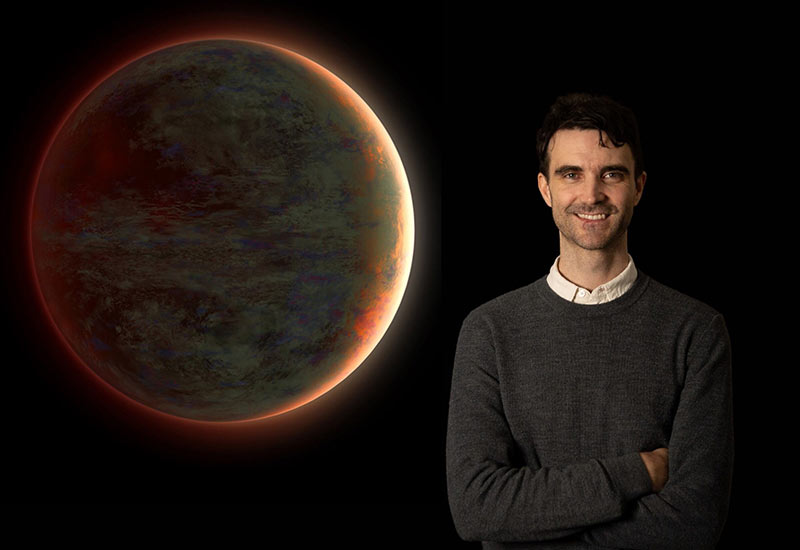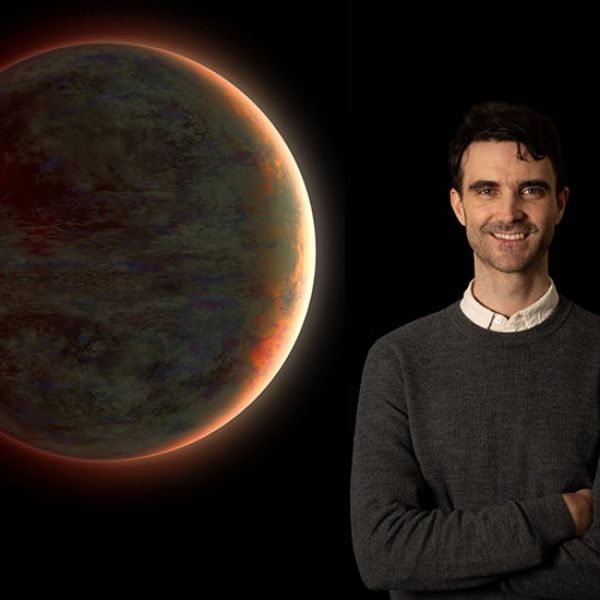Exoplanets and the search for life beyond Earth
Dr Tom Soma-Evans
It’s a question that fascinates us all: Is there life on other planets? But for Dr Tom Evans-Soma, finding habitable planets is part of his daily research. To do this, he works with his team, global colleagues and powerful space telescopes.

Tom is an astronomer. His focus is on studying planets outside our solar system, known as ‘exoplanets’.
Astronomers have discovered thousands of exoplanets over the past decade. Tom and his team measure as many of them as they can to understand what they’re made of and what their climates are like.
“We’re exploring and trying to make sense of the diversity of planetary systems that have formed around other stars,” he explains.
“This work is part of the overarching quest to understand how our own planetary system originated and evolved over time and how we fit into the Universe more broadly.”
Tom specialises in using powerful space telescopes to do this work. These telescopes include the Hubble Space Telescope and the James Webb Space Telescope.
He also works closely with colleagues making similar measurements using some of the world’s largest ground-based telescopes, including the Very Large Telescope in Chile.
A fascination with the night sky
Tom says he got into astronomy because the beauty of the night sky inspired him. He also loved using the scientific method and was curious about what lies beyond Earth.
He studied science at The Australian National University (ANU) and was especially interested in astronomy. During that time, he started learning about the many exoplanets being discovered in the early 2000s.
“I was, and still am, amazed that humans have wondered about other worlds around the stars for thousands of years. But it’s only in the last couple of decades that our technology has become advanced enough to start testing that idea with science”, says Tom.
“I feel very lucky to be living at a time like this. It’s now possible to make real progress on this exciting frontier of knowledge.”
Like many others in his field, Tom is especially driven by the age-old question: Is there life elsewhere in the Universe?
He believes the best way to answer this question is by searching for biosignature gases in the atmospheres of habitable exoplanets. The work he’s doing now is laying the groundwork for these measurements in the future.
Using light to determine presence of life
The ultimate goal for Tom and his team is to take an image of an ‘Earth Twin’ exoplanet. An 'Earth Twin' exoplanet is an Earth-sized planet that orbits a Sun-like star at a similar distance to Earth's orbit around the Sun.
“Imagine taking an image of an Earth Twin around another star. What we’d see is the bright star in the centre of the image with a tiny pinprick of light orbiting it,” Tom explains.
“If we took that image using the optical wavelengths we can see with our eyes, that tiny point of light would be light that originated from the star and was then reflected back to space by the Earth Twin.”
It's like when you see a satellite photo of Earth. You're seeing sunlight reflected off the planet. But if the image were taken in infrared, you'd be seeing the heat coming from Earth itself, not just reflected sunlight.
Whether it’s Earth or a distant planet, the light it reflects and the heat it gives off are changed by their interaction with the planet. These changes depend on what the planet is made of, both on its surface and in its atmosphere.
“If we could measure the reflected starlight and thermal emission from an Earth Twin, we could search for the telltale signatures of gases in the planet’s atmosphere that might be imprinted on that light, like methane, water vapour, and ozone,” he says.
If they found certain gases together, such as methane and ozone, Tom says it would be a strong indication of life on that planet. By making the same measurements on ten or more Earth-like planets, they could begin to figure out how common or rare life is around other stars.
Distance: the big technical challenge
Understanding how often life arises on planetary systems across the galaxy is an incredibly ambitious goal. But today’s scientists might be able to achieve it.
Yet, Tom shares that the technical challenges are daunting.
The main challenges are how far away these planets are from us and how dim an Earth-like planet would be compared to its star.
“To understand how tough it is to capture an image of an Earth-like planet, picture this. Take a small, shiny metal ball about the size of a pea and place it 80 metres away from a 1000-watt lightbulb. This wattage is like the big floodlights at a sports stadium.
Next, move both the pea and the lightbulb 330,000 kilometres away, the same distance from the Earth to the Moon.
At this distance, imagine trying to take a picture that clearly shows the faint reflection of the pea-sized ball while separating it from the bright light of the bulb. This is similar to what our telescopes will have to do to detect the reflected light from a nearby Earth-like twin.”
While the best telescopes around today are impressive, there’s still a way to go.
For example, using the Hubble Space Telescope, Tom and his team could detect the reflection from the metal ball if it were one metre wide instead of the size of a pea. They would also need both the ball and the lightbulb moved ten times closer—about 33,000 kilometres away from us.
Enormous Earth-twin excitement
The challenges are significant. But Tom says there’s a lot of excitement and motivation among astronomers around the world to capture images of Earth-like planets. Huge investments are being made to build the physical hardware and develop the imaging technologies needed to turn observations of Earth Twins into reality.
Giant ground-based telescopes, such as the Extremely Large Telescope in Chile, which is almost 40 metres wide, are being built. However, to overcome these challenges and capture a true Earth Twin, Tom says we’ll probably need a special space telescope built just for this purpose.
“While such a space telescope wouldn’t need to be as large as the Extremely Large Telescope, it would still need a mirror the same size as the one on the James Webb Space Telescope. It would also need a camera and optical system of incredible sophistication.”
Building such a telescope has been confirmed as a major priority by NASA. Their goal is to launch it in the 2040s and detect reflected starlight from at least 25 Earth Twins.
The European community is also making plans to launch a complementary space telescope. This telescope would observe the thermal emission from Earth Twins.
Hot Jupiters, water worlds and the cosmic hunt
The telescopes needed to study Earth Twins will be created over the coming decades. Tom shares that there’s still plenty of exciting work to do in the meantime.
“Right now, the James Webb Space Telescope (JWST) is revolutionising the way we study the atmospheres of larger exoplanets. These planets are more like the ice giants and gas giants in our solar system.”
“For example, my team and I have been using JWST to study the extreme atmospheres of 'hot Jupiters’." These are Jupiter-sized planets that orbit so close to their stars that their atmospheres are heated to over 1000 degrees Celsius.”
They’re also undertaking a major JWST observing campaign to search for another exotic class of planet known as ‘water worlds’.
These water worlds are believed to be made largely of water and are between the sizes of Earth and Neptune. They’re thought to be a common result of planet formation.
But Tom and his team need to measure the atmospheric compositions of the most promising water world candidates to determine whether they truly are water worlds or not. As well as shedding light on a previously unstudied class of planet, this will provide an important test of the current understanding of how planets form.
“If a water world existed at the right distance from its star, where the temperature allowed water to stay liquid, the planet could have a global ocean. This ocean could be 100 km deep.”
“Further from the star, where temperatures are colder, a water world would freeze and turn into an ice planet. Although its surface would be covered in ice, it could still have a subsurface ocean, similar to a larger version of Jupiter’s moon Europa.”
In both of these cases, Tom explains, the ocean of a water world might even have the potential to harbour life. However, this remains pure speculation for now.
Only time will tell if we’re alone in the Universe. There’s great hope the science being carried out by Tom, his team, and stargazers around the world will give us an answer.
The University of Newcastle acknowledges the traditional custodians of the lands within our footprint areas: Awabakal, Darkinjung, Biripai, Worimi, Wonnarua, and Eora Nations. We also pay respect to the wisdom of our Elders past and present.
